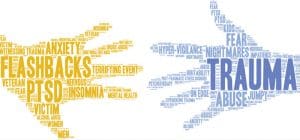This resource helps organizations create a positive practice environment.
Takeaways:
- Workplace stress has an alarming impact on nurse well-being.
- Pathway to Excellence framework can serve as a framework for promoting staff well-being and resilience.
The image of the nurse holding up an iPad so a dying patient can say good-bye to his family speaks volumes about the stress experienced by nurses during the COVID-19 pandemic. Themes already prevalent in everyday conversation about nurse well-being, such as emotional exhaustion and burnout, have escalated to conversations around post-traumatic stress disorder (PTSD). Healthcare organizations have an obligation to address the potential for PTSD by creating structures and processes that support building resilience and provide treatment resources. (See About PTSD.)
About PTSD


Mealer and colleagues (2009) define post-traumatic stress disorder (PTSD) as “exposure to a traumatic event or extreme stressor that is responded to with fear, helplessness, or horror.” PTSD symptoms include
- avoidant behavior
- difficulty concentrating
- flashbacks
- nightmares
- panic attacks
- sleep disturbances.
PTSD symptoms tend to increase during a global crisis, but more concerning are the nurses suffering from PTSD related to everyday practice.
- Before the pandemic, a study by Sanchez and colleagues reported PTSD indicators in as high as 48% of ICU nurses and 17% of nurses working outside of the ICU.
- Inoue and colleagues found that 21% of psychiatric nurses who had been exposed to workplace verbal abuse or violence experienced severe psychological effects.
- According to Falkenberg and colleagues, only two out of five people seek help during the first year they experience PTSD symptoms.
Many interventions already exist. For example, the Post-Traumatic Stress Syndrome 10-question inventory, a self-report scale based on Diagnostic and Statistical Manual of Mental Disorders criteria, can help organizations assess staff risk for the condition. In addition, organizations can provide support services that help staff feel safe to share what they’re feeling and provide access to therapeutic interventions such as yoga, meditation, and “oasis rooms” during the workday to aid resilience, a characteristic Mealer and colleagues (2012) found to be associated with a significantly lower prevalence of PTSD. Other strategies include minimizing triggers associated with PTSD, such as enforcing zero-tolerance measures for workplace violence.
However, these efforts can’t occur piecemeal. They function as part of an integrated well-structured, comprehensive approach. The Pathway to Excellence® Framework provides this structure.
How Pathway to Excellence addresses PTSD
The American Nurses Association (ANA) reports that self-care, stress management, and resilience can help lower PTSD risk. The Pathway to Excellence Framework, with its dedicated standard for well-being, guides organizations in creating a positive practice environment where nurses feel cared for and valued. Melnyk and colleagues found elevating staff well-being and addressing their mental health critical to ensuring safety and high-quality care delivery. The six evidence-based standards included in the 2020 Pathway to Excellence® and Pathway to Excellence in Long-Term Care® Application Manual are designed to ensure organizational prioritization of staff and patient safety. (See 6 standards.)
6 standards


The six Pathway to Excellence Framework standards guide organizations in creating a positive practice environment. The standards described here apply within the context of post-traumatic stress disorder prevention.
- Shared decision-making. Nurse involvement in efforts to decrease workplace stress includes facilitating collaboration, improving resource availability, and addressing staffing concerns.
- Leadership. Leaders set the tone for a healthy work environment. Dans and Lundmark found that leader accessibility and staff involvement in decision-making processes facilitate nurse empowerment and adaptability.
- Safety. This standard addresses several factors related to well-being: workplace violence, adverse events, repeated stressors, and post-traumatic stress syndrome (PTSD). It helps organizations foster integrative solutions that enhance staff well-being, build resilience, and manage PTSD in challenging times.
- Quality. Pathway to Excellence organizations embrace a quality framework driven by a mission to create a culture that enhances organization, patient, and staff well-being. According to a study by Owens and colleagues, a positive relationship between staff and the organizational mission improves engagement and reduces burnout.
- Well-being. Research, including an American Nurses Association report, indicates that rigid system structures can result in poor staff health and well-being outcomes. Nurses frequently don’t prioritize their self-care, requiring organizations to foster well-being and build a foundation for resilience. According to Melnyk and colleagues, organizations that involve staff in selecting and developing well-being processes not only safeguard the health of their employees, but also enhance care quality.
- Professional development. Comprehensive new staff orientation that highlights the reduction of bullying is foundational for developing competent and collaborative staff. ANA promotes nurses’ commitment to creating a welcoming and supportive atmosphere for new nurses.
Testimonials from the field
Two organizations that have received Pathway to Excellence designation demonstrate how they used the Pathway to Excellence Framework to support staff well-being, minimize PTSD risk, and foster resilience during challenging times.
University Medical Center of Southern Nevada
University Medical Center (UMC) of Southern Nevada found that using the Pathway to Excellence Framework helped build a positive practice environment essential to staff well-being. After a traumatic incident that occurred several years before the COVID-19 pandemic, the organization began using the framework to respond to staff psychological needs.
On October 1, 2017, a shooter opened fire on a crowd of concertgoers on the Las Vegas Strip, killing 58 people and injuring 869. Veronica Dunn-Jones, MSN, RN, a nurse at UMC’s Burn Center, wrote, “Our focus was to try and make our patients feel safe. But, for those moments, the look of fear and panic in everyone’s eyes as they continued to do their work is something I will never forget. Some of our staff had friends or family who were at the Route 91 concert and were missing. Some were just in shock of what was going on around us. We would all have to sit and process all of what had occurred on that night. It was 7:30 am before I could head home. I tried to sleep and could not. My head could not shut off. I tossed and turned for several hours and eventually got up and went back to work for debriefing.”
Already well into their Pathway to Excellence journey, UMC had strategies in place to address staff well-being. During the incident, UMC highlighted three Pathway to Excellence Standards: Shared Decision Making, Leadership, and Well-being. Leadership committed to being accessible, providing reinforcement and support to facilitate decisions. The staff received daily updates from leadership, chief executive officer weekly messaging, and chief nursing officer virtual and live rounds.
To minimize post-traumatic stress, the organization encouraged staff to access the employee assistance program and in-house psychiatric personnel for debriefing and individual or team counseling sessions. In addition, employees participated in hospital blood drives, and UMC social services spearheaded distributing victim and family assistance resources information. Each of these activities permitted staff to voice a personal commitment to recovery.
Earlier in 2017, a nurse-driven well-being initiative resulted in the first staff tranquility room. Staff used it around the clock for respite in the days after the disaster. The tranquility room has since evolved into the Tranquility @ UMC program with additional staff interventions, including healing touch, music, aromatherapy, and workstation diffusers. The program also includes integrative therapy nurses who round on staff and encourage them to step away and regroup when necessary. These interventions have been essential during the pandemic.
To address increased demand, UMC is working with a company to convert sleep pods into additional tranquility rooms. In alignment with the Pathway to Excellence Quality and Well-being standards, UMC plans to conduct a research pilot study on the effects of the Tranquility @ UMC program in decreasing stress and improving coping.
Northampton General Hospital
Northampton General Hospital NHS Trust (NGH), the first hospital in the United Kingdom to achieve Pathway to Excellence designation, developed the Supporting our Staff (SoS) program based on the understanding that listening is fundamental to healing.
The SoS team includes nurses and other healthcare staff trained in Trauma Risk Management (TRiM), which was pioneered by the Royal Marines. After a traumatic event, the TRiM process uses an evidence-based risk assessment tool to evaluate and manage colleagues’ psychological needs. TRiM also includes a whole-incident response plan to assess the event and develop strategies to address it—for example, briefings for the whole team or one-on-one risk assessments 72-hours after the incident, 1-month follow-up risk assessments, and referrals for professional support.
When the pandemic reached the United Kingdom, the SoS referral system went silent. Despite clear distress among colleagues and high levels of activity within the hospital, no one was accessing it. It wasn’t until a staff member died of COVID-19 that an avalanche of referrals came through. Initially, individuals felt their experience wasn’t “bad enough” and felt shame that they were struggling. Many staff members suffered moral injury when they weren’t able to provide needed care. In addition, a resurgence of pre-existing mental health conditions occurred.
The SoS team provided a listening service. As part of this service, the team normalized emotions (it’s okay not to be okay) and provided education about restoring balance. The team also sat, listened, shared, and cried during each shift. The trauma was palpable, and all staff were given the opportunity to be heard. When necessary, the team made referrals for professional services. In addition, interprofessional SoS teams ensure the right listening ears are matched with the right individuals. Most importantly, support comes from the board to the ward. NGH has long understood the importance of well-being, a value reinforced in the Pathway to Excellence Standards.
Committed to well-being
The Pathway to Excellence Framework fosters the health and well-being of staff, equipping them and their organizations to manage the many stressors—from a single catastrophic event to daily stressors that build over time—that contribute to PTSD. UMC and NGH have created cultures committed to staff well-being. Each organization’s program was well established before COVID-19 reared its ugly head, better preparing them psychologically for the agonizing months that followed.
Patience Harris is a senior RN specialist for Pathway to Excellence at the American Nurses Credentialing Center in Silver Spring, Maryland. Leigh Hume is assistant director at Pathway to Excellence. Debra Fox is chief nursing officer at University Medical Center of Southern Nevada in Las Vegas. Cathleen Hamel is director of professional practice, shared leadership, and Pathway to Excellence program director at the University Medical Center of Southern Nevada. Moya Flaherty is staff support lead for organisational development at Northampton General Hospital NHS Trust in Cliftonville Northampton, United Kingdom.
References
American Nurses Association. Nurse suicide prevention/resilience.
American Nurses Credentialing Center. 2020 Pathway to Excellence® and Pathway to Excellence in Long-term Care® Application Manual. Silver Spring, MD: American Nurses Credentialing Center; 2020.
Dans M, Lundmark V. The effects of positive practice environments: Leadership must-knows. Nurs Manage. 2019;50(10):7-10. doi:10.1097/01.numa.0000580624.53251.29
Falkenberg I, Valmaggia L, Byrnes M, et al. Why are help-seeking subjects at ultra-high risk for psychosis help-seeking? Psychiatry Res. 2015;228(3):808-15. doi:10.1016/j.psychres.2015.05.018
Inoue M, Tsukano K, Muraoka M, Kaneko F, Okamura H. Psychological impact of verbal abuse and violence by patients on nurses working in psychiatric departments. Psychiatry Clin Neurosci. 2006;60(1):29-36. doi:10.1111/j.1440-1819.2006.01457.
Mealer M, Burnham EL, Goode CJ, Rothbaum B, Moss M. The prevalence and impact of post traumatic stress disorder and burnout syndrome in nurses. Depress Anxiety. 2009;26(12):1118-26. doi:10.1002/da.20631
Mealer M, Jones J, Newman J, McFann KK, Rothbaum B, Moss M. The presence of resilience is associated with a healthier psychological profile in intensive care unit (ICU) nurses: Results of a national survey. Int J Nurs Stud. 2012;49(3):292-9. doi:10.1016/j.ijnurstu.2011.09.015
Melnyk BM, Kelly SA, Stephens J, et al. Interventions to improve mental health, well-being, physical health, and lifestyle behaviors in physicians and nurses: A systematic review. Am J Health Promot. 2020;34(8):929-41. doi:10.1177/0890117120920451
Melnyk BM, Orsolini L, Tan A, et al. A national study links nurses’ physical and mental health to medical errors and perceived worksite wellness. J Occup Environ Med. 2018;60(2):126-31. doi:10.1097/jom.0000000000001198
Owens K, Eggers J, Keller S, McDonald A. The imperative of culture: A quantitative analysis of the impact of culture on workforce engagement, patient experience, physician engagement, value-based purchasing, and turnover. J Healthc Leadersh. 2017;9:25-31. doi:10.2147/JHL.S126381
Sanchez M, Simon A, Ford D. PTSD in Tx ICU nurses. J Heart Lung Transplan. 2019;38(4 suppl):S93-4.
Whybrow D, Jones N, Greenberg N. Promoting organizational well-being: A comprehensive review of Trauma Risk Management. Occup Med (Lond). 2015;65(4):331-6. doi:10.1093/occmed/kqv024



















1 Comment. Leave new
Great & informative & relatable